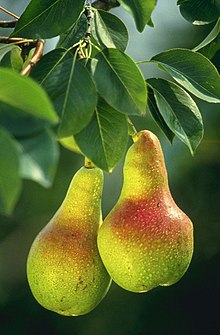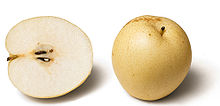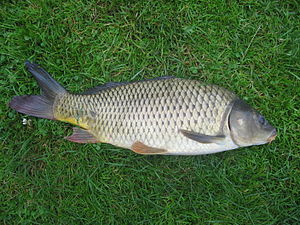Pear
"Pyrus" redirects here. For other uses, see Pyrus (disambiguation).
For other uses, see Pear (disambiguation).
| This article needs additional citations for verification. (January 2007) |
| ||||||||||||||||||||||||||||||||
The pear is any of several tree and shrub species of genus Pyrus (pron.: /ˈpaɪrəs/), in the family Rosaceae. It is also the name of the pomaceous fruit of these trees. Several species of pear are valued by humans for their edible fruit, while others are cultivated as ornamental trees. The genus Pyrus is classified in subtribe Pyrinae within tribe Pyreae.
Storage
Pears may be stored at room temperature until ripe.[14] Pears are ripe when the flesh around the stem gives to gentle pressure.[14] Ripe pears are optimally stored refrigerated, uncovered in a single layer, where they have a shelf life of 2 to 3 days.[14]
[edit]Uses
Pears are consumed fresh, canned, as juice, and dried. The juice can also be used in jellies and jams, usually in combination with other fruits or berries. Fermented pear juice is called perry or pear cider.
Pears ripen at room temperature. They will ripen faster if placed next to bananas in a fruit bowl.[15]Refrigeration will slow further ripening. Pear Bureau Northwest offers tips on ripening and judging ripeness: Although the skin on Bartlett pears changes from green to yellow as they ripen, most varieties show little color change as they ripen. Because pears ripen from the inside out, the best way to judge ripeness is to "Check the Neck": apply gentle thumb pressure to the neck or stem end of the pear. If it yields to gentle pressure, then the pear is ripe, sweet, and juicy. If it is firm, leave the pear at room temperature and Check the Neck daily for ripeness.[16]
The culinary or cooking pear is green but dry and hard, and only edible after several hours of cooking. Two Dutch cultivars are "Gieser Wildeman" (a sweet variety) and "Saint Remy" (slightly sour).[17]
Pear wood is one of the preferred materials in the manufacture of high-quality woodwind instruments and furniture. It is also used for wood carving, and as a firewood to produce aromatic smoke for smoking meat or tobacco. Pear wood is valued for kitchen spoons, scoops and stirrers, as it does not contaminate food with color, flavor or smell, and resists warping and splintering despite repeated soaking and drying cycles. Lincoln[18] describes it as "a fairly tough, very stable wood... (used for) carving... brushbacks, umbrella handles, measuring instruments such as set squares and T-squares... recorders... violin and guitar fingerboards and piano keys... decorative veneering." Pearwood is the favored wood for architect's rulers because it does not warp. It is similar to the wood of its relative, the apple tree, Pyrus malus (also called Malus domestica) and used for many of the same purposes.[18]
[edit]Health benefits
| ||||||||||||||||||||||||||||||||||||||||||||||||||||||
Pears are a good source of dietary fiber and a good source of vitamin C. Most of the vitamin C, as well as the dietary fiber, is contained within the skin of the fruit.[21]
Pears are less allergenic than many other fruits, and pear juice is therefore sometimes used as the first juice introduced to infants.[22] However, caution is recommended for all fruit juice consumption by infants, as studies have suggested a link between excessive fruit juice consumption and reduced nutrient intake, as well as a tendency towards obesity.[23] Pears are low in salicylates and benzoates, so are recommended in exclusion diets for allergy sufferers.[24] Along with lamb and rice, pears may form part of the strictest exclusion diet for allergy sufferers.[25]
Most of the fiber is insoluble, making pears a good laxative.[26]
[edit]Herbalism
In ancient Greece, pears were used to treat nausea.
[edit]Cultural references
Pears grow in the sublime orchard of Alcinous, in Odyssey vii: "Therein grow trees, tall and luxuriant, pears and pomegranates and apple-trees with their bright fruit, and sweet figs, and luxuriant olives. Of these the fruit perishes not nor fails in winter or in summer, but lasts throughout the year."
'A Partridge in a Pear Tree' is the first gift in "The Twelve Days of Christmas" cumulative song, this verse is repeated twelve times in the song.












